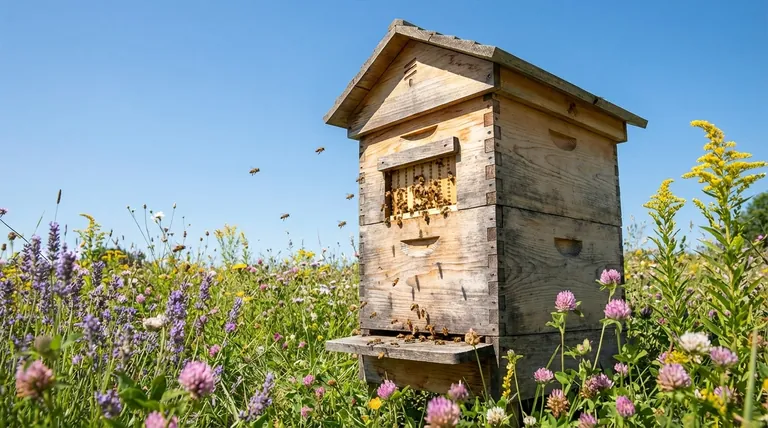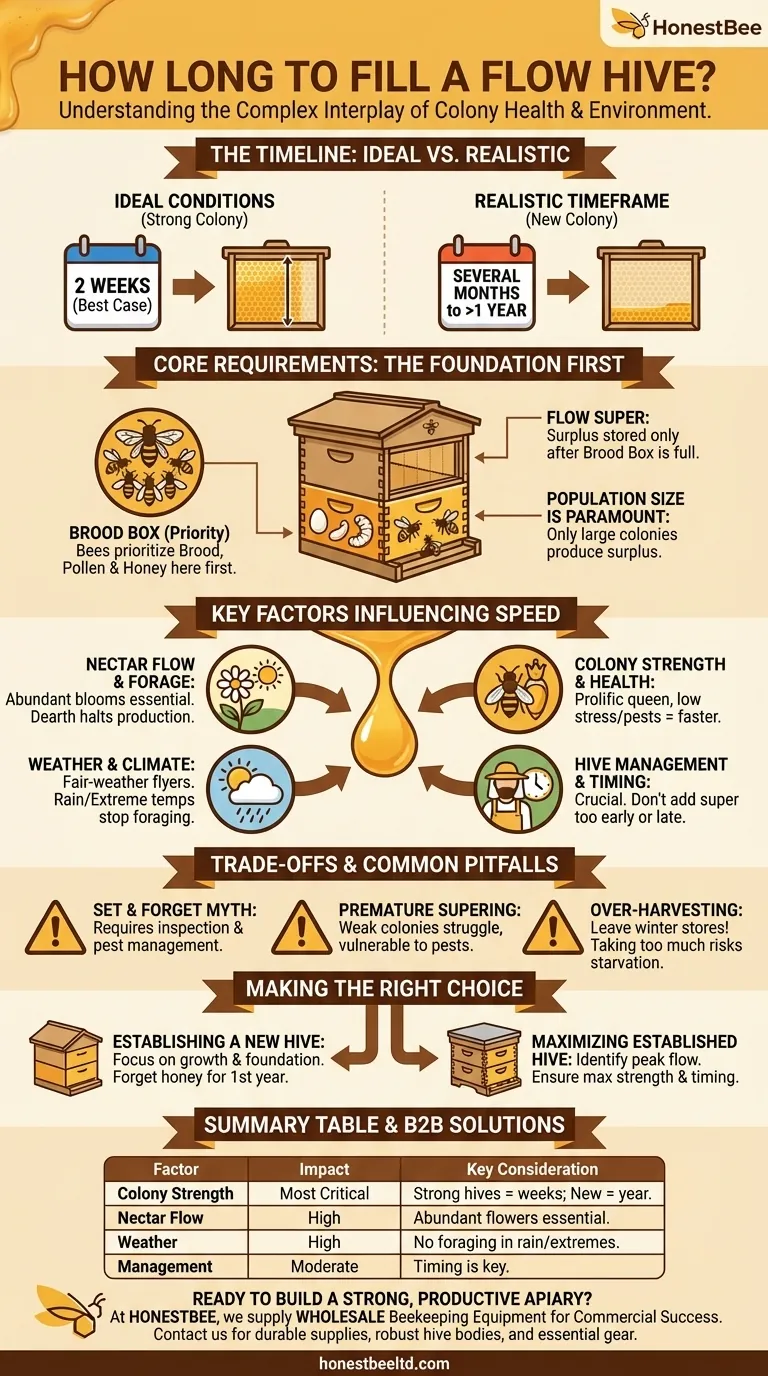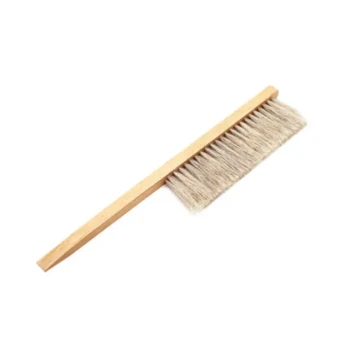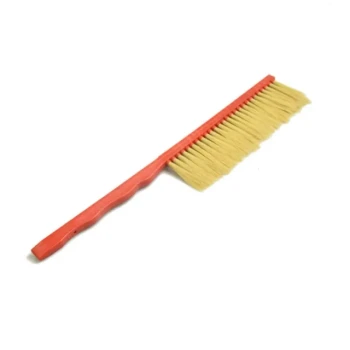Under ideal conditions, a strong, healthy honeybee colony can begin to fill a six-frame Flow Super in as little as two weeks. However, this is a best-case scenario, and the actual time can vary dramatically based on a number of critical factors. A more realistic timeframe for a new colony is often several months to over a year.
The question isn't just about the Flow Hive itself, but about the complex interplay between the environment and the honeybee colony. Your primary focus should be on creating the conditions for a strong hive, as honey production is a direct result of its health and resources.

The Core Requirements: What Bees Need First
Before bees will even consider storing surplus honey in your Flow Frames, they must secure the foundation of their colony. This work happens in the brood box, the lower section of the hive.
The Brood Box Foundation
The brood box is the heart of the colony. It's where the queen lays eggs and the bees raise the next generation of workers.
Bees will always prioritize filling the brood box with honey, pollen, and brood before they move upward to store surplus honey in a super (including a Flow Super).
Population Size is Paramount
A small or newly established colony has a simple priority: grow. All their energy and resources are dedicated to raising more bees and building a strong population.
Only a large, booming population has the workforce necessary to gather more nectar than the colony needs for its immediate survival. This surplus is what becomes your honey harvest.
Key Factors Influencing Honey Production Speed
The timeline for filling a Flow Hive is not a fixed number; it's a direct reflection of several powerful variables. Understanding these is the key to managing your expectations and your hive.
Nectar Flow & Forage Availability
This is the single most important factor. A nectar flow is a period when one or more major floral sources are blooming abundantly, providing a massive influx of resources.
Without a strong, local nectar flow, bees cannot produce surplus honey, no matter how strong the colony is. If conditions become dry or flowers stop blooming (a period called a nectar dearth), bees may even consume the honey they've already stored in the Flow Frames to survive.
Colony Strength & Health
A large, healthy colony with a prolific queen and minimal stress from pests or diseases will forage more efficiently and fill frames much faster than a weak one. A hive fighting off varroa mites or other issues will divert energy away from honey production.
Weather and Climate
Bees are fair-weather flyers. Long periods of rain, extreme heat, cold, or high winds will keep them inside the hive, halting all nectar collection and honey production. Your local climate dictates the length of your beekeeping season.
Hive Management & Timing
The beekeeper's role is crucial. Adding the Flow Super too early can stretch a small colony's resources too thin, as they struggle to patrol and manage the extra space.
Adding it too late means you may have missed the peak nectar flow, significantly reducing your potential harvest.
Understanding the Trade-offs & Common Pitfalls
The Flow Hive is a remarkable tool for harvesting, but it does not change the fundamental principles of beekeeping. Avoiding common misconceptions is critical for success.
The "Set and Forget" Misconception
A Flow Hive is not an automated honey factory. It requires the same level of inspection, pest management, and environmental awareness as any other beehive. The innovation is in the extraction method, not the beekeeping itself.
The Danger of Premature Supering
Placing the Flow Super on a new or weak colony is a common mistake. Bees may ignore it completely, or worse, struggle to defend the vast, empty space, making them vulnerable to pests like wax moths and hive beetles.
Over-harvesting and Colony Survival
It can be tempting to drain every frame, but the honey in the hive belongs to the bees first. You are only harvesting their surplus. Always ensure you leave enough honey for the colony to survive the winter or a sudden nectar dearth. Taking too much can lead to starvation.
Making the Right Choice for Your Goal
Your approach should be guided by the maturity of your hive and your primary objective for the season.
- If your primary focus is establishing a new hive: Forget about honey for the first year. Concentrate entirely on supporting colony growth, managing pests, and ensuring the bees have enough resources to build a strong foundation in their brood box.
- If your primary focus is maximizing honey from an established hive: Learn to identify the peak nectar flow in your specific area. Your goal is to ensure the hive is at maximum strength just as the flow begins and to have the Flow Super ready for them to use.
Ultimately, beekeeping is a partnership where success is measured not just in honey, but in the health and resilience of the colony you steward.
Summary Table:
| Factor | Impact on Filling Time | Key Consideration |
|---|---|---|
| Colony Strength | Most Critical | Strong, established hives can fill frames in weeks; new hives may take a year. |
| Nectar Flow | High | Abundant local flowers are essential; no flow means no surplus honey. |
| Weather & Climate | High | Bees don't forage in rain, extreme heat, or cold, pausing production. |
| Hive Management | Moderate | Adding the super too early or too late can drastically reduce harvest. |
Ready to build a strong, productive apiary?
At HONESTBEE, we supply commercial apiaries and beekeeping equipment distributors with the high-quality, durable supplies needed for success. From robust hive bodies to essential protective gear, our wholesale-focused operations ensure you get the reliable equipment that supports healthy colonies and maximizes honey production.
Contact our team today to discuss your wholesale needs and let us help you build a more resilient and profitable operation.
Visual Guide

Related Products
- Automatic Honey Flow Beehive 4 Frame Mini Hive for Beekeeping
- 7 x Auto Bee Flow Hive Frames Plastic Beekeeping Hive Box Supplies
- HONESTBEE Professional Long Handled Hive Tool with Precision Cutting Blade
- HONESTBEE Advanced Ergonomic Stainless Steel Hive Tool for Beekeeping
- Honey Flow Garden Bee Hive Flow Hive Best Beehive for Beginners
People Also Ask
- What are the advantages of using a Flow Hive? Simplifying Harvesting for Modern Beekeepers
- What are the benefits of a Flow Hive? Revolutionize Your Harvest with Ease and Care
- What are the advantages of using an Auto Flow Hive? Experience Gentle, On-Tap Honey Harvesting
- How does the Flow Hive simplify honey harvesting? The Revolutionary 'Honey on Tap' System Explained
- How to extract honey in Flow Hives? Experience the Simplicity of Honey on Tap



















